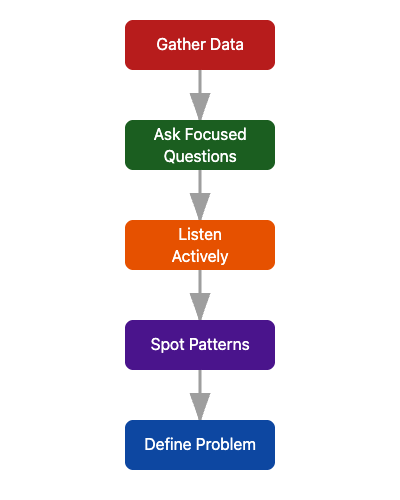When you’re faced with project problems, it’s tempting to jump to quick fixes. But the real magic happens when you use data to dig deeper and solve issues at their core. Think of data as your project’s GPS: it doesn’t just tell you where you are, it helps you find the best route forward. When you move from “We’re always behind schedule” to “Our handoff process between design and engineering causes a 3-day delay each sprint,” you’re not just guessing — you’re leading with clarity and confidence.
In this lesson, you’ll learn how to:
- Use data and stakeholder input to uncover what’s really causing project headaches.
- Break down complex problems with the 5 Whys framework.
- Turn insights into practical actions that move your project forward.
By the end of this lesson, you’ll know how to spot the real issues behind project setbacks and use data to guide your next steps. So, how do you move from guesswork to clarity? It all starts with diagnosing the problem using data.
Looking at the data can help solve the mystery of why problems are happening. Start by checking out metrics, timelines, bug counts, and other reports as these clues can reveal why a project is running slower, making less progress, or seeing more bugs than usual.
Once you have some data, talk to the people closest to the work. Instead of asking, “Why are we behind?” try, “What changed in our process during the last two sprints that could explain the increase in bugs?” Listen for pain points and patterns — maybe the requirements aren’t clear at the start of each sprint, or there’s another recurring issue.
By combining hard data with real feedback, you get a much clearer picture of what’s actually slowing you down.
We can use the Data-to-Insight Framework for getting to the root of project issues:

1. Gather Data: What do the numbers and reports say?
2. Ask Focused Questions: What’s changed? Where are the bottlenecks?
3. Listen Actively: What are team members and stakeholders experiencing?
4. Spot Patterns: Where do the data and feedback overlap?
5. Define the Real Problem: What’s the specific issue you need to solve?
Once you’ve got your data and insights, it’s time to make sense of them. Strategic frameworks, like the 5 Whys, help you move from “something’s wrong” to “here’s what we can do about it.”
5 Whys: The 5 Whys is a simple but powerful technique for getting to the root cause of a problem. You start with a problem statement and keep asking “why?”, usually around five times, until you uncover the underlying issue. Each answer forms the basis of the next question, helping you move past surface symptoms to what’s really going on.
Let's look at an example of how this can play out in conversation:
- Jessica: Hey Chris, I noticed the feature was delivered late this sprint. Do you know what happened?
- Chris: Development actually started later than planned.
- Jessica: Why did development start late?
- Chris: Because the requirements weren’t finalized on time.
You’ve found the root cause! Now it’s time to do something about it. Turning insights into action is what drives real change on your project. Here’s a simple action plan you can follow:
Action Plan Checklist:
- Identify the root cause
- Brainstorm possible solutions
- Choose the best action
- Implement the change
- Monitor results
For example, if you discover that “handoffs are delayed due to missing documentation,” you might implement a new rule:
“No task is marked complete until documentation is attached.”
Or, if unclear requirements are the issue, you could add a pre-sprint review checklist. The key is to let the data guide your decisions so your solutions are targeted and effective.
By using data, asking the right questions, and applying simple frameworks, you’ll move from firefighting to strategic problem-solving while building trust with your team along the way. Next up: you’ll practice these skills in a role-play, working with a technical lead to uncover the root causes of repeated project delays. Get ready to ask focused questions, listen actively, and use data to drive real change.
